Chawanmushi is a classic Japanese savory custard that‘s steamed in a delicate cup. We season smooth and silky custard with dashi stock and add tender chicken pieces, kamaboko fish cake, and mushrooms. Make this famous appetizer for your guests for a true Japanese home cooking experience.{Vegetarian adaptable}
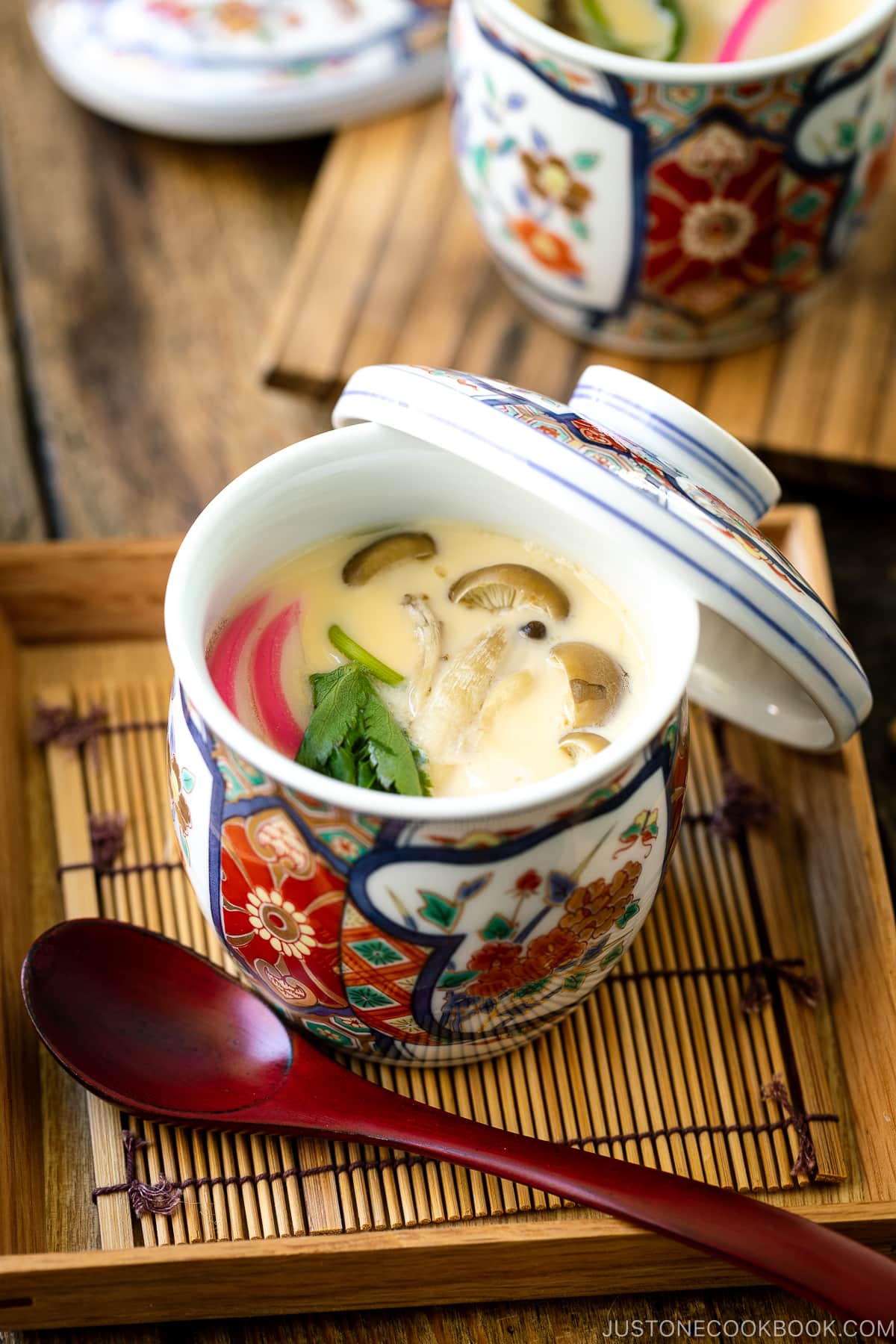
Served in a dainty little teacup, chawanmushi (茶碗蒸し) is a classic appetizer on the menu in many sushi or Japanese restaurants. There are many variations based on seasonal ingredients, but some of the most common ones include shrimp, fish, and vegetables. It can be homey or fancy depending on what goes into the egg custard. To get you started, I’ll be sharing a basic chawanmushi recipe with chicken, along with suggestions for vegetarian version.
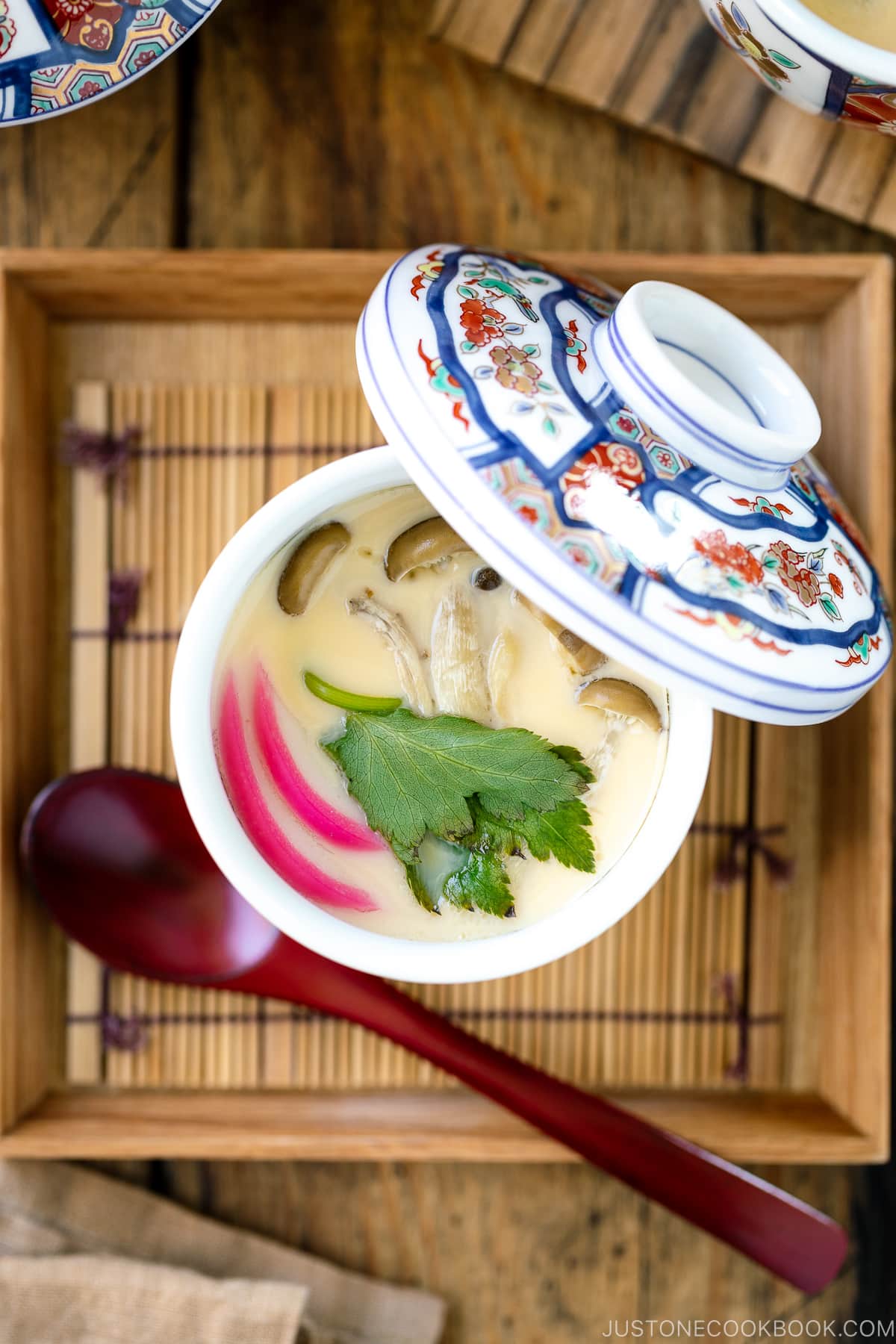
What is Chawanmushi?
Chawanmushi (茶碗蒸し) literally translates to ‘teacup steamed egg custard’. We fill the egg mixture with ingredients such as ginkgo nuts, shiitake mushrooms, kamaboko (Japanese fish cake), and subtly flavored with dashi, soy sauce, and mirin. It is steamed in a cup and often served as a cold or hot appetizer. With an ivory color and lovely toppings, it is as tasty as it looks.
- The texture: The steamed custard is smooth & silky, while the sweet-savory meat and vegetables lend a contrasting mouthfeel to the dish. And there’s juice from the broth, which makes each bite utterly satisfying and surprising.
- The flavor: You can expect a delicate yet complex flavor from a good cup of chawanmushi. There is a balance of sweetness and saltiness from the different components. And the seasonings—dashi, soy sauce, mirin, and sake—attribute an umami taste, which is key to making a delicious custard.
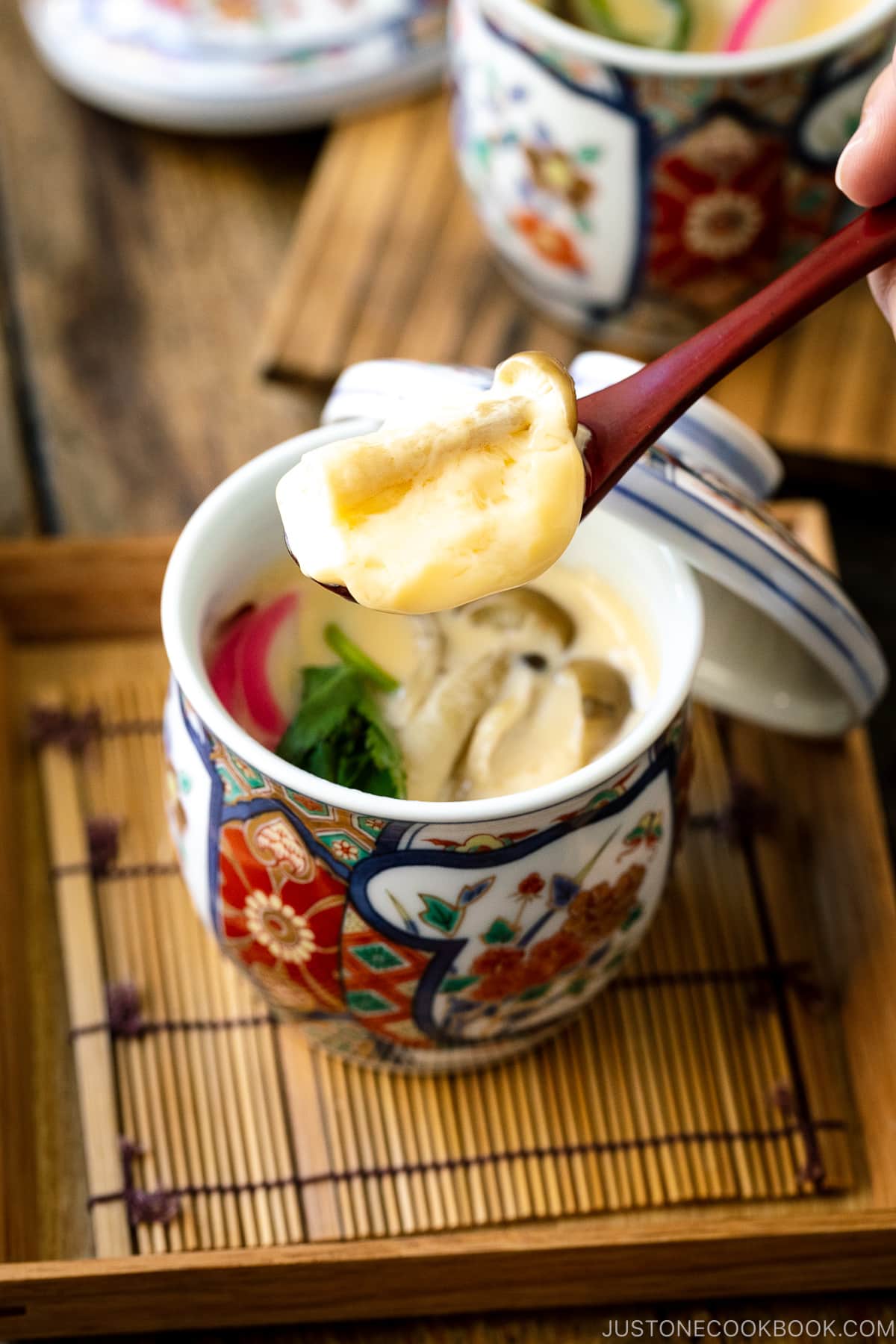
How to Make Chawanmushi
Ingredients You’ll Need
- Eggs
- Dashi (Japanese soup stock) – I highly recommend making dashi from scratch or using a dashi packet (instead of dashi powder) since the broth defines the taste of the dish. Use kombu dashi for a vegetarian version.
- Condiments: Soy sauce, mirin, sake, and salt
- Chicken – I used chicken tenders today, but it can be chicken thigh or breast. Skip for a vegetarian version.
- Kamaboko fish cake – Skip for a vegetarian version.
- Mushrooms – I used shimeji mushrooms.
- Ginkgo nuts (gin-nan) – optional
- Mitsuba – or diagonally sliced green onion
Vegetarian Substitutions:
Instead of using chicken and fish cake, you can use various mushrooms and vegetables. Depending on what you use, you may need to blanch or cook the vegetable first (such as carrot).
Where to buy Chawanmushi Cups:
Chawanmushi is typically served in a special small cup with a lid. You can buy chawanmushi cups at Japanese supermarkets or Asian grocery stores, or online on Amazon or other Japanese cookware retailers.
Alternatively, you can use heat-resistant ramekins, pretty little small bowls, or mugs to prepare the savory steamed custard. Just make sure they are not too thick as the heat will be hard to penetrate.
Overview: Cooking Steps
- Cut all the ingredients.
- Make the custard mixture by combining the eggs, dashi, and condiments.
- Assemble the ingredients and custard mixture in chawanmushi cups.
- Steam for 20 minutes.
- Serve hot.
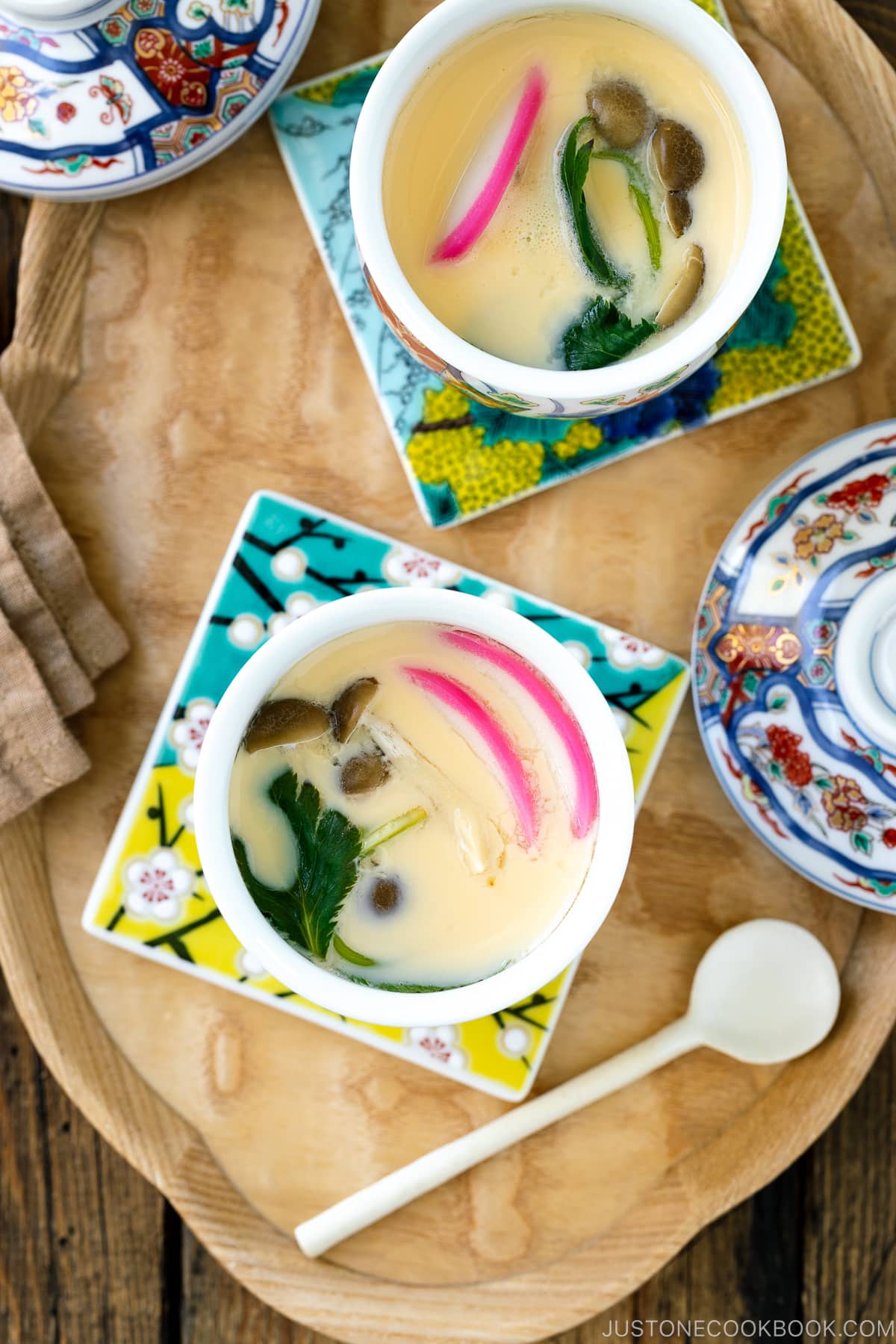
Steamer Setups
Chawanmushi must be cooked with gentle heat, or the custard will have small tiny bubbles and the texture of the custard becomes rough. You can use the following 3 methods to cook chawanmushi.
1. Cook in a pot with gently simmering water
I use this method for my recipe here. Please read the instructions on the recipe card below.
Boil water in a large pot that can fit the steaming cups. Once boiling, reduce the heat to the lowest setting. Gently place the cups inside the hot water and cover the pot with the lid leaving it ajar to let the hot steam escape. This creates a gentle steaming condition inside the steamer.
2. Steam in a steamer basket
You can use a traditional steamer to make chawanmushi. You do not need to cover the chawanmushi cups. Instead, wrap the steamer lid with a large kitchen towel so that condensation from the lid won’t drop into the egg custard while steaming. Place the steamer cups in the steamer and leave the lid ajar to let the hot steam escape. This creates a gentle steaming condition inside the steamer.
3. Steam in the oven
Preheat the oven to 350ºF (180ºC) and fill a roasting pan (or deep baking dish) with 1″ (2.5 cm) boiling water. Cover the steaming cups with the lid or aluminum foil and place them inside the roasting pan.
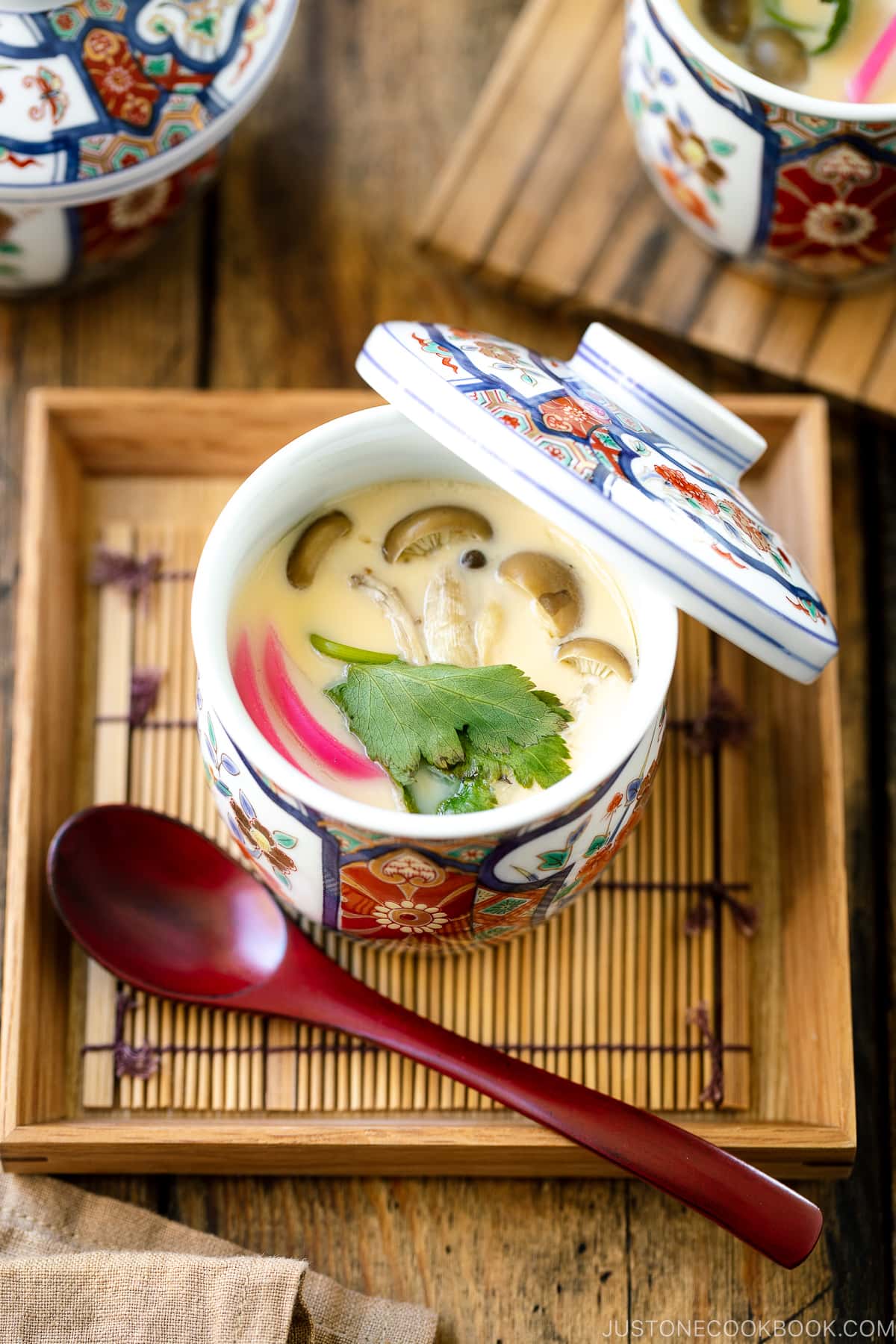
Five Chawanmushi Cooking Tips
Tip #1: The egg-to-dashi ratio is 1 to 2.5.
Many professional chefs and home cooks use the egg-to-dashi ratio 1 to 3. However, I prefer slightly more egg taste in my chawanmushi, so I use 2.5.
How do we calculate? First, measure the weight of the eggs, and then multiply by 2.5 to get the amount of dashi you need.
For instance, 3 eggs (150 g) x 2.5 = 375. So you will need 375 ml of dashi.
Tip #2: Strain the egg mixture.
Straining the egg mixture through a fine-mesh sieve helps to separate any stringy strands of egg whites so you get a smooth and silky custard.
Tip #3: Use room temperature ingredients.
Make sure your ingredients are not cold or frozen. The egg mixture will cook fast and your ingredients may not cook through. Also, spread out the ingredients so the heat can go through; for example, put the chicken in a single layer instead of stacking up.
Tip #4: Use gentle heat to cook and keep the lid slightly ajar.
When your steamed chawanmushi has a porous texture with tiny visible holes, which we call them “su,” it’s considered a failure.
These holes in the steamed egg custard are a clear indicator for overcooking or using high heat. Your goal is to make chawanmushi without these holes.
To achieve that, you must be careful with cooking time and heat control. Keep your pot lid slightly ajar and use a gentle heat. The simmering water should be 176-194ºF (80-90ºC). Avoid boiling the custard mixture or the finished custard will not be smooth.
Tip #5: Check doneness by inserting a skewer.
When you insert a bamboo skewer into the center of the chawanmushi and clear juice comes out, it’s done. If the juice is not clear, you will need to cook it longer. You can also tilt the chawanmushi cup to see if it is solidified, but be careful as the cups are extremely hot.
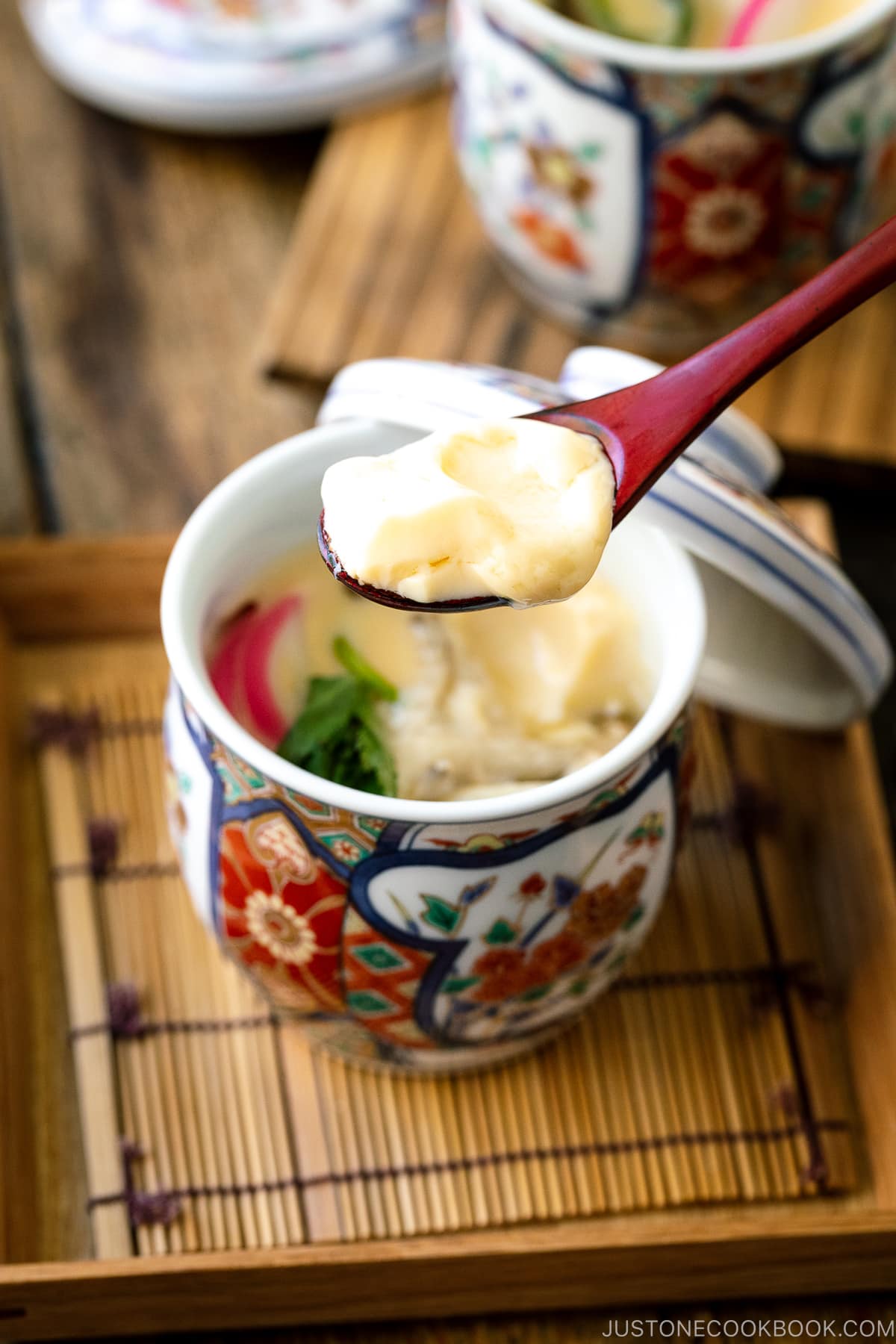
How to Enjoy Chawanmushi
Chawanmushi is typically served hot as an appetizer. Since the custard is very delicate and breaks easily, we eat chawanmushi with a small wooden or lacquer spoon.
Where to Buy Chawanmush Cups and Spoons
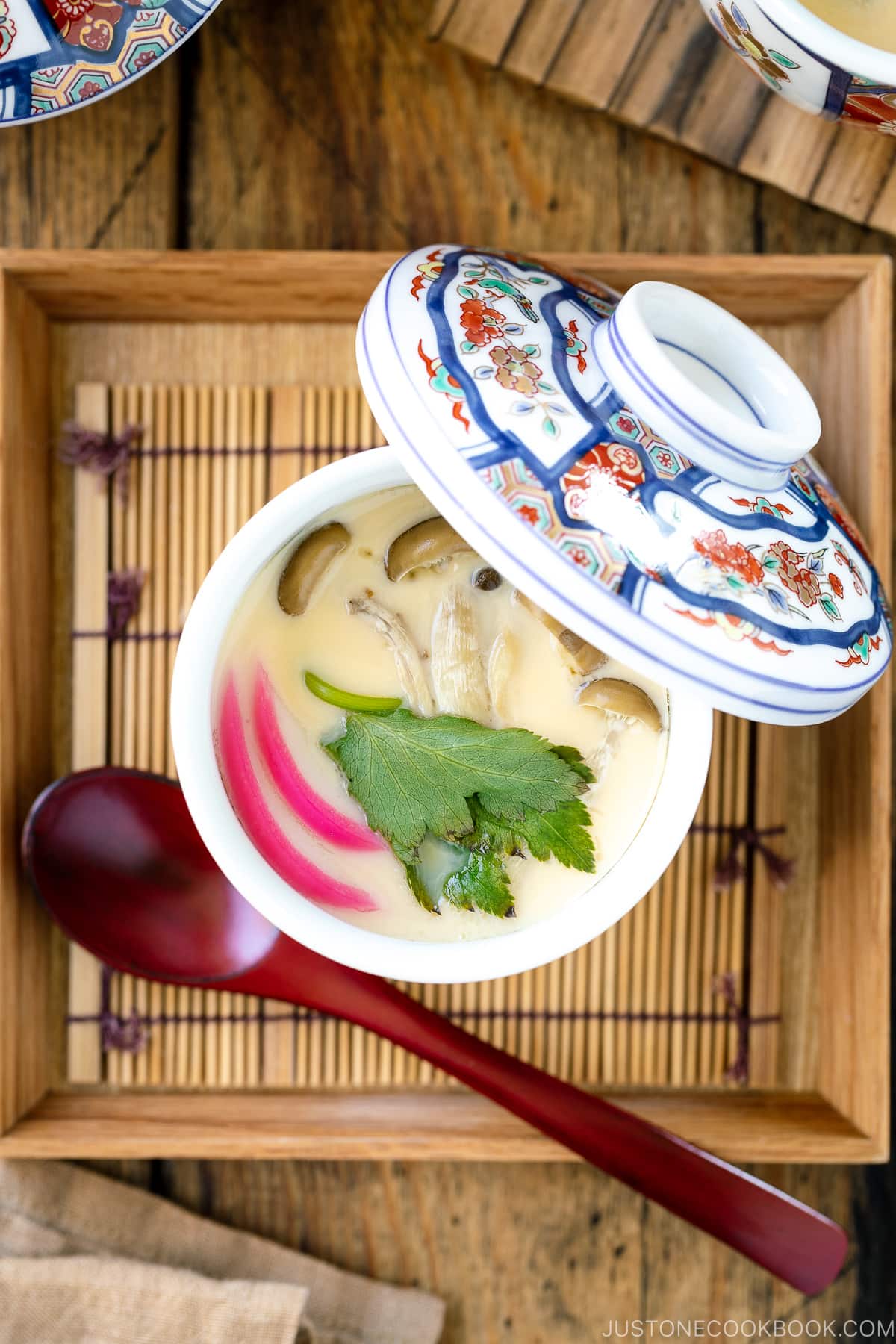
Other Delicious Chawanmushi Recipes
There is really nothing like a silky custard with a savory broth topped with delicacies to soothe the hungry stomach while you wait for the main meal to be served. I hope you give this recipe a try because it is easy and practical to make at home.
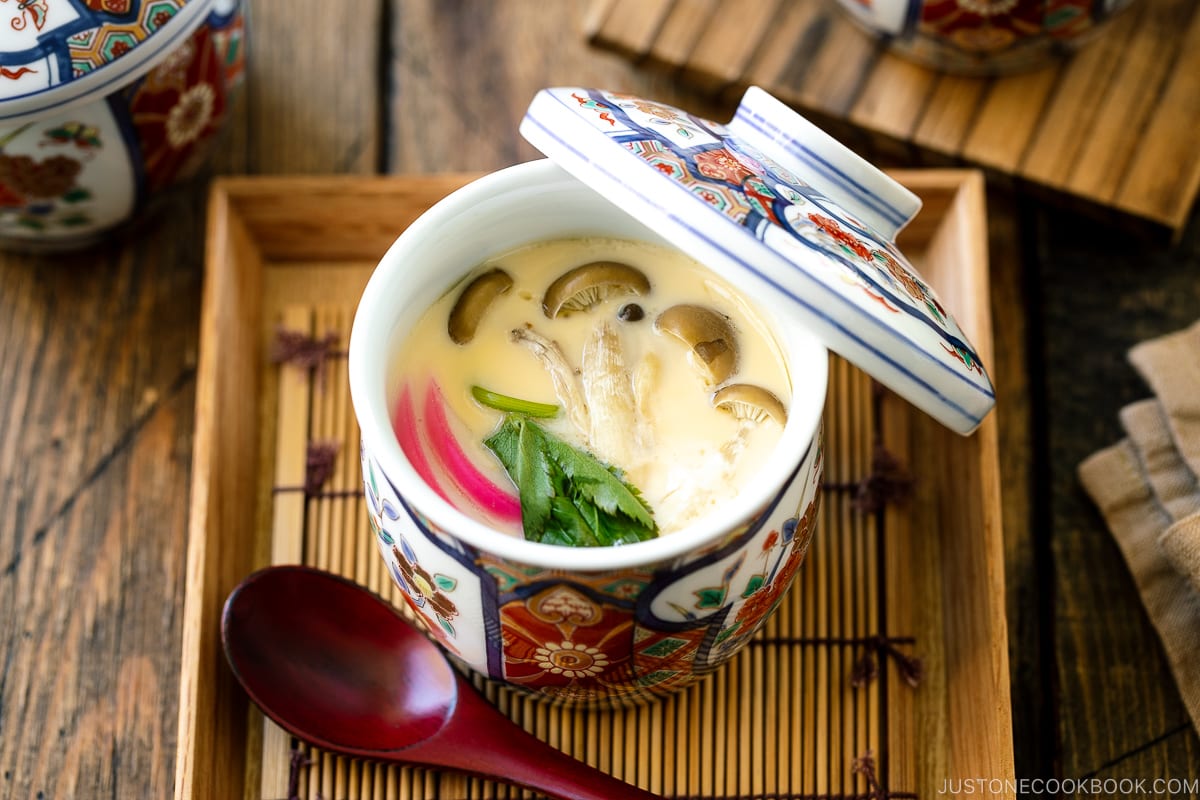
Wish to learn more about Japanese cooking? Sign up for our free newsletter to receive cooking tips & recipe updates! And stay in touch with me on Facebook, Pinterest, YouTube, and Instagram.
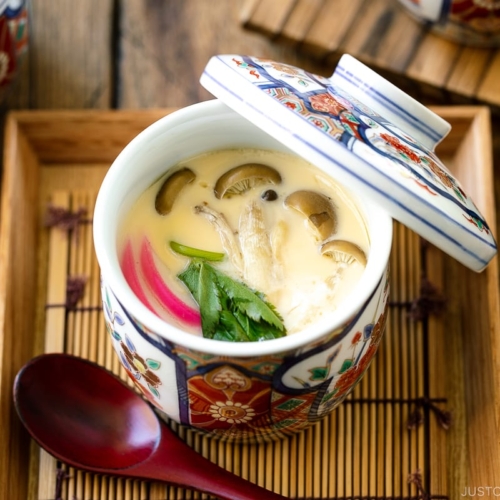
Chawanmushi (Savory Steamed Custard)
Chawanmushi is a classic Japanese savory custard that‘s steamed in a delicate cup. We season smooth and silky custard with dashi stock and add tender chicken pieces, kamaboko fish cake, and mushrooms. Make this famous appetizer for your guests for a true Japanese home cooking experience. {Vegetarian adaptable}
Ingredients
Prevent your screen from going dark
Instructions
To Prepare the Hot Water Bath
-
In a large pot, place the chawanmushi cups (with their lids on) to make sure they fit in the pot. Then, pour enough water to reach halfway up the sides of the cups. Remove the cups and cover the pot with a lid. Bring the water to a boil and turn off the heat. Meanwhile, prepare the ingredients.
To Prepare the Ingredients
-
Gather all the ingredients.
-
Cut 2 chicken tenders into ½-inch (1.3 cm) pieces and put them in a tray or bowl. Add 1 Tbsp sake to coat the chicken pieces and set aside for 10 minutes.
-
Cut your 8 slices kamaboko (fish cake) thinly. Trim off the bottom of 1.8 oz shimeji mushrooms and separate them into small clusters.
-
Make a knot in each stem of 4 sprigs mitsuba (Japanese parsley) (see photo). If you are using green onion instead, cut it into thin slices.
To Make the Custard
-
Place a 4-cup measuring cup or a large bowl on a kitchen scale and tare the scale. Crack 3 large eggs (50 g each w/o shell) into the measuring cup or bowl. Note the egg weight and multiply by 2.5 to calculate how much dashi to add. (Use a 1-to-2.5 ratio of eggs to dashi. For example: 150 g eggs x 2.5 = 375 ml dashi.) To the eggs, add your calculated amount of dashi.
-
Next, add 1 tsp mirin, 1 tsp soy sauce, and ½ tsp Diamond Crystal kosher salt to the cup with the eggs and dashi. Tip: Use usukuchi soy sauce, if you have it. This light-colored soy sauce keeps the custard from getting dark.
-
Whisk it all together. Make sure the egg whites and yolks are combined well.
-
Then, strain the egg mixture through a fine-mesh sieve into another bowl. This helps to get a refined silky texture.
To Assemble the Chawanmushi
-
Divide equally all the ingredients into the chawanmushi cups: First, add the chicken (in a single layer), followed by the shimeji mushrooms, and finally the 8 ginkgo nuts (optional).
-
Then, place the more colorful ingredients like kamaboko and mitsuba on top. Gently pour the egg mixture into the cups about 80% full, leaving some of the top ingredients uncovered. You might not use all the egg mixture due to the size of your cups and the amount of ingredients you added. Remove any air bubbles with a spoon or pop them with a skewer. Tip: Air bubbles will create a rough texture once the custard is cooked.
To Steam the Chawanmushi
-
Bring the water in the pot to a boil again. Once boiling, reduce the heat to the lowest setting. Carefully place the cups with their lids on in the hot water and cover the pot, leaving the lid slightly ajar. Gently cook for 20 minutes on the lowest heat. If you omit the chicken, cook for only 15 minutes (depending on how much custard is in the cups). Tip: Aim for a temperature of 176–194ºF (80–90ºC) for the simmering water. Do not boil the egg mixture or the finished custard will not be smooth.
-
To check if the Chawanmushi is done, insert a skewer in the center of the steamed custard; if clear liquid comes out, it‘s done. Or, tilt the cup to see if the mixture is runny; it‘s done if the custard is set. Carefully remove the cups from the hot water. I removed the lids first and then the cups themselves using a hot plate gripper (here‘s a similar one).
Nutrition
Nutrition Facts
Chawanmushi (Savory Steamed Custard)
Amount per Serving
% Daily Value*
* Percent Daily Values are based on a 2000 calorie diet.
Editor’s Note: This post was originally published on September 7, 2011. It’s been republished on October 2, 2022, with more content, new images, and a slightly revised recipe.

